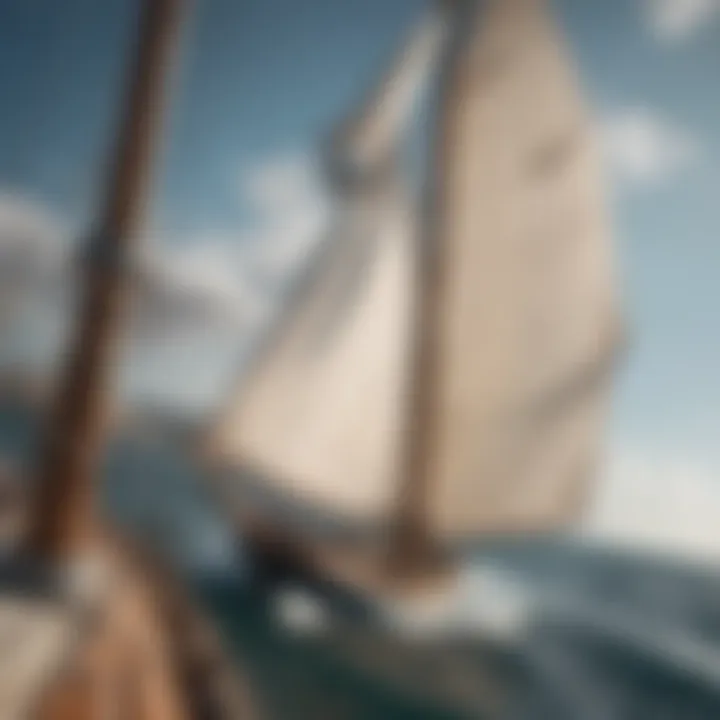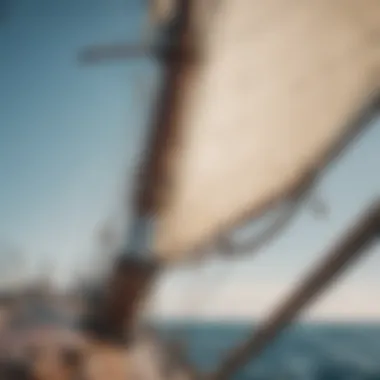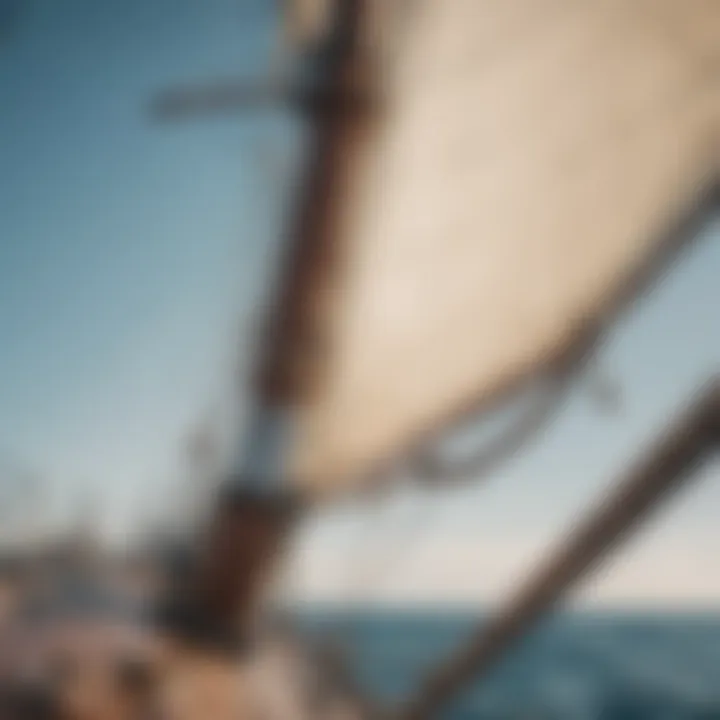Exploring the Principles and Mechanics of Sails


Intro
Sailing captures the imagination with its promise of adventure and freedom. But beneath the surface of this captivating pastime lies a rich tapestry of mathematics, physics, and design that enhances the experience. An intricate understanding of sails and how they interact with wind can turn a simple sailboat ride into a symphony of harmony between man and nature. Whether you’re a landlubber or a seasoned mariner, grasping the mechanics of sails can enhance your excursion significantly.
What makes sails tick? From the basic principles of aerodynamics to the nuanced adjustments sailors make while out on the water, the answers lie in the details. This article seeks to illuminate not just how sails function, but the skills, techniques, and safety considerations required for a fulfilling sailing experience.
Let’s embark on this voyage by diving into the foundational knowledge every sailor should have.
Techniques and Skills
Fundamental Techniques for Beginners
When starting out in sailing, it’s vital to familiarize oneself with core techniques that underpin the sport. These basics lay the groundwork for more advanced maneuvers later.
- Understanding Wind Direction: One must learn to read the wind, which involves identifying where it’s coming from. You can practice by observing the ripples on water or noting the way trees sway.
- Sail Trim: This refers to adjusting the sails for optimal performance. Beginners should master the art of trimming sails, which calls for an understanding of how to pull in or let out the sails depending on wind conditions. Proper trim translates to better speed and control.
- Tacking and Gybing: These maneuvers are essential for changing direction. Tacking involves turning the bow of the boat into the wind, whereas gybing means passing the stern through the wind. Practice in calm waters to build confidence.
- Basic Knot Tying: Knowing how to tie a few good knots—like the bowline or cleat hitch—is fundamental. Knot tying is as essential as it is practical, ensuring sails are securely fastened to avoid mishaps.
Advanced Skills for Experienced Athletes
Once you've graduated from the basics, it’s time to enhance your skills further. Experienced sailors often rely on more intricate techniques to gain a competitive edge.
- Sailboard Tuning: This technique requires adjusting the sails for wind conditions while on the move. It can mean a difference of speed and agility in competitive sailing.
- Weather Helm vs. Lee Helm: Understanding the balance of your boat can be crucial. Weather helm is when the boat wants to turn into the wind, while lee helm tries to drift with the wind. Tuning your rigging can help define this balance.
- Spinnaker Handling: For those interested in racing, deploying a spinnaker (a type of sail designed for downwind leg) requires precision. Seamlessly transitioning into and out of spinnaker usage can be a game-changer.
"Mastering the helm is not simply a matter of strength; it lies in finesse, judgment, and a keen understanding of nature's forces."
The development of these advanced maneuvering techniques not only elevates performance but enriches the overall sailing experience. An intimate communication with both the vessel and the environment is crucial.
Safety and Gear
Essential Safety Measures in Watersports
Safety can never be overstated in sailing. There is something inherently unpredictable about being out on water. Awareness and precaution must be the first mates to every sailor. Here are essential measures:
- Life jackets: These should be worn by all aboard at all times.
- Communication Devices: Carry a VHF marine radio or a satellite phone for emergencies.
- Weather Awareness: Different conditions can change like the flipping of a coin. Keep an eye on weather forecasts before setting sails.
- First Aid Kit: Always have a stocked first aid kit and know basic first aid principles.
Gear Reviews and Recommendations
Investing in the right gear makes all the difference. Below are some recommended products that every sailor should consider:
- Hydration Packs: Staying hydrated is essential during long voyages. Brands like CamelBak provide reliable options.
- Sailing Gloves: Gloves enhance grip and protect hands from wear and tear. Look for padded versions from companies like Gill.
- Multi-tools: A good multi-tool can serve many purposes aboard. Brands such as Leatherman offer durable options.
- Sail Covers: Protect your sails when not in use. Consider options from West Marine, known for their durability.
The Basics of Sailing
Understanding the basics of sailing is akin to grasping the foundation of a building; without a solid base, everything else tends to be shaky. This section offers crucial insight into the essential components of sailing—each element plays a pivotal role in the functionality and performance of a sailboat. When combined, these basics ensure that both novice sailors and seasoned mariners can maneuver through waters with competence and confidence.
Foreword to Sailing Mechanics
When one first sets foot on a sailboat, there's a certain magic in observing how the various parts work in harmony. Sailing is not only about having the right equipment; it's about understanding how each element functions. This includes recognizing how wind interacts with sails, how adjustments can be made for optimal performance, and what techniques help navigate the waters effectively.
From the hull that cuts through waves to the technological instruments that provide vital information, each component of a sailboat contributes significantly to the overall experience of sailing. By mastering these sailing mechanics, an individual becomes more adept at handling challenges faced on open waters.
Components of a Sailboat
A comprehensive look at a sailboat reveals three main elements: the hull, mast, and boom. Each serves a critical purpose and understanding these can help any sailor leverage their vessel’s capabilities.
Hull
The hull of a sailboat is its backbone, providing buoyancy and stability. This primary structure is designed to keep the boat afloat and allows for various designs tailored for specific conditions—think of it like the engine room of a car. A catamaran hull, for instance, is famous for its stability, ideal for those who seek comfort while slicing through waves. The key characteristic that makes the hull stand out is its shape; a well-designed hull reduces drag and enhances speed.
One unique feature of hulls is their construction material—many modern boats boast fiberglass hulls, which are durable yet relatively lightweight. However, while this material is quite popular, factors like cost and maintenance should be considered. Wood, though timeless and beautiful, demands regular upkeep.
Mast
The mast is essentially the spine of the sailboat, holding the sails in place and allowing them to catch the wind. Its height and rigidity are crucial as they determine how effectively sails can harness wind energy. A taller mast can accommodate larger sails, leading to increased speed. However, increased height often translates to stability challenges, especially in high winds.
This component is frequently made from lightweight materials like aluminum or carbon fiber, making it both strong and responsive. The standout feature of the mast is its capability to adjust; sails can be raised, lowered, or even reefed depending on wind conditions. Yet, it’s essential to remember that improper adjustments can create excessive strain, risking damage.
Boom
The boom acts similarly to an arm that helps control the angle of the sail. Think of it as an extension of the mast that, when properly utilized, ensures that sailors can efficiently manage their sails’ position relative to the wind. The key characteristic of a boom is its ease of maneuverability; sailors often swing it across the boat to optimize wind capture.
A unique benefit of the boom is that it allows for finer tuning of sail shape—crucial for navigating into the wind. However, an important caution is that it swings quickly, especially during tacks, which can pose safety risks. Therefore, awareness and communication among crew members are a must while sailing.
"Understanding the components of a sailboat is essential for mastering the art of sailing; each piece contributes to the overall maneuverability and enjoyment of the experience."
In summary, grasping the basics of the hull, mast, and boom lays a strong groundwork for a sailor's journey. These components inform how to deal with various sailing conditions, making every outing not only enjoyable but also educational.
Aerodynamics and Sails
Understanding aerodynamics is crucial for grasping how sails work. Sails convert wind energy into movement, and the principles of aerodynamics dictate this transformation. Without a healthy dose of knowledge about how air flows over and around sails, one would struggle to control a sailboat effectively.
Understanding Wind Dynamics
Laminar vs Turbulent Flow
When we talk about laminar versus turbulent flow, we are really diving into how wind interacts with the sail's surface. Laminar flow is characterized by smooth, parallel layers of air. These layers slide uniformly past each other, creating lower drag. In contrast, turbulent flow is a chaotic mix where vortices form, increasing drag but also enhancing lift in certain circumstances.
The relevance of these flows in sailing is significant. A sail that maintains laminar flow can achieve optimal efficiency at lower wind speeds. However, in strong winds, a bit of turbulence can actually be beneficial, as it helps maintain airflow over the sail longer. The trick is knowing how to adjust the sail to encourage the desired flow.


- Key characteristics of laminar flow: Low drag, smooth airflow.
- Key characteristics of turbulent flow: Chaotic airflow, potential for increased lift.
Pressure Differences
Pressure differences play a pivotal role in generating lift—a key element of sailing. When wind encounters a sail, it splits, flowing above and below the surface. Due to its shape, air moves faster over the top of the sail than underneath, resulting in lower pressure above and higher pressure below. This difference creates lift, allowing the boat to move forward.
Understanding pressure differences allows sailors to optimize the angle of their sails relative to the wind direction. Adjustments to the sail’s position can significantly influence these pressure zones, enhancing performance.
- Key characteristics of pressure differences: Lift generation, impact on sail position.
- Unique feature: Sail shape fundamentally influences these differences, underscoring the importance of specific designs for various wind conditions.
How Sails Harness Wind
Lift vs Drag
The interplay between lift and drag is essential for understanding a sail's function. Lift is what propels a boat forward, while drag is the opposing force that can slow it down. A well-designed sail maximizes lift while minimizing drag.
In the grand scheme, most sailors aim for configurations that enhance lift. This might mean adjusting sail shape or angle based on wind conditions, consistently seeking that sweet spot where the sail draws maximum energy from the wind without being overly constrained by drag.
- Key characteristics of lift: Generates forward motion, depends on pressure difference.
- Key characteristics of drag: Resists motion, related to surface area and airflow.
Angle of Attack
The angle of attack is another crucial aspect. It refers to the angle between the sail and the oncoming wind. A sail's angle can dramatically alter lift and drag. When the angle is favorable, lift increases, and the boat can sail more efficiently. However, if the angle becomes too steep, the risk of stalling—where the sail loses lift altogether—increases.
Sailors must constantly adjust their sails based on the wind’s strength and direction, making the angle of attack an ever-present consideration. This responsiveness is what differentiates a seasoned sailor from a novice.
- Key characteristics of angle of attack: Influences lift and drag, requires constant adjustment.
- Unique feature: Smaller angles are beneficial in light winds, while larger angles can work well in stronger gusts, reflecting the sailor's knack for skillful adjustments.
Effective management of aerodynamics not only enhances speed but also ensures safety at sea. A sailor's awareness of wind dynamics and control over the sails through knowledge of lift, drag, and angle of attack can make all the difference in navigating the vast waters.
Types of Sails
The discussion of sails wouldn't be complete without taking a closer look at the various types available. Understanding the Types of Sails is crucial for anyone looking to navigate the waters effectively. Each type of sail has its unique features and attributes, influencing how a boat performs under specific wind conditions. This isn’t just about preference—certain sails offer distinct benefits, while others might present their own challenges. Depending on the sailing activity, the choice of sail can alter everything from speed to ease of handling.
Square Sails
Square sails are some of the oldest designs known to seafaring history. These sails are characterized by their rectangular shape, hung squarely across the yardarm of a mast. The primary benefit of square sails lies in their ability to catch wind from a beam reach, allowing for powerful propulsion. They are often seen on larger vessels, like traditional tall ships, where the horizontal surface area can be maximized.
However, there's a catch; square sails are generally less versatile than other designs. They do not perform as effectively when sailing against the wind or at sharp angles. This means they can be labor-intensive for the crew, requiring more effort to maneuver and control. Such sails require ample skill and experience, making them more suited to those who are familiar with the waves and winds.
Fore-and-aft Sails
Fore-and-aft sails refer to a category that includes sails like jibs and mainsails, designed to be rigged lengthwise along the boat's hull. This configuration allows for more efficient sailing, especially when navigating windward. Their versatility means they are the preferred choice for many modern yachts and smaller sailing vessels.
Jibs
Jibs play a vital role in improving a boat's performance by providing a forward balance and enhancing the overall aerodynamic profile. The key characteristic of a jib is its position and functionality; it is set in front of the mainsail, allowing the boat to gain speed even in lighter winds. This makes jibs a popular option since they can significantly boost performance without much added complexity.
A unique feature of jibs is their varying sizes and shapes; they can be designed for different wind conditions. While they are generally easier to handle and can be adjusted quickly on the fly, they do have some drawbacks. For instance, they may not generate as much power as larger sails or can be less effective in heavy winds.
Mainsails
Mainsails are the principal driving force of a sailboat and are generally the largest sail on the vessel. Their significance cannot be overstated; the size and shape of the mainsail can dramatically impact speed and maneuverability. A mainsail's central positioning allows for optimal harnessing of the wind, making it a benefitting choice in a wide range of sailing conditions.
One of the unique features of mainsails is their adaptability—sailors can trim or reef them depending on the wind's intensity. While they offer considerable advantages, like increased power and control, there's also a downside. Mainsails require regular maintenance and careful handling; a malfunction could lead to significant issues in maneuverability during a critical moment.
Specialized Sails
In addition to the more common sails, there are specialized options available, perfect for meeting specific sailing needs. These sails are designed for performance under unique conditions and can elevate the sailing experience.
Genoas
Genoas are commonly used in racing and cruising. Their defining feature is their large area, which extends beyond the mast's front. This size allows for excellent wind capture, resulting in impressive speed even in light wind scenarios. The key characteristic of genoas is their ability to provide a significant boost in both downwind and beam reaches, making them a favorable choice for competitive sailors.
However, leveraging a genoa might pose some challenges. The larger area can sometimes be difficult to manage, especially for less experienced sailors. Overreaching can also create issues in strong winds when sudden maneuvers are needed.
Spinnakers
Spinnakers are often seen as the showstoppers of sail designs. These are large, balloon-like sails, typically used for downwind sailing. Their unique shape and large surface area allow them to catch the wind efficiently, propelling the boat forward dramatically. The impact of spinnakers on a sailing experience can be exhilarating, making them a popular choice for racing and fun outings alike.
However, spinnakers are not without complications. They can be tricky to handle, especially if wind conditions change suddenly. If mismanaged, they can create unwanted drag or turbulence, impacting performance negatively. It’s important for sailors using spinnakers to be aware of such potential pitfalls and to be trained properly.
The choice of sails can fundamentally alter your sailing experience. Every kind has its unique advantages and challenges, making the understanding of these components essential for optimized sailing practices.
Sail Design and Materials
Understanding the nuances of sail design and materials is crucial in the vast realm of sailing, where every sailor seeks to harness the wind's energy effectively. The right sail design not only impacts performance but also the sailing experience as a whole. Various factors determine the choice of materials, including durability, weight, and environmental adaptations.
A well-crafted sail combines aesthetics and function, offering optimal shape and efficiency while withstanding the elements. Sail design has revolutionized over the years, taking into account not just the physics of aerodynamics, but also technological advancements in materials. This blend of innovation and tradition fuels the ongoing pursuit of better sails, guiding sailors toward enhanced performance.
Historical Evolution of Sail Design
Historically, sails were simple; fabric stretched over a wooden frame. Early sailors used natural fibers like flax or cotton. Gradually, technology and understanding guided a metamorphosis. Seafaring cultures experimented with sail shapes, from the square sails of ancient vessels to the triangular sails favored in modern times. Each shift in design aimed to maximize how the wind was captured, which resulted in improved speed and maneuverability.
The introduction of more resilient and lightweight materials marked a significant blessing. Materials that took centuries to evolve are now central to sailing. Knowledge passed down through generations, combined with scientific principles, gave rise to innovative designs, paving the way for what we see in modern sailing today.
Modern Sail Materials


In contemporary sailing, material choice plays a pivotal role in sail performance. Three primary materials stand out—Dacron, Mylar, and composite materials. Each serves unique purposes, making them favorites among sailors.
Dacron
Dacron is a polyester material renowned for its strength and lasting durability. This fabric has been a staple in sail-making, largely because it resists stretching and remains stable under a vast array of conditions. It's lightweight yet sturdy, making it an attractive option for cruising sails. One standout feature of Dacron is its ability to withstand the UV rays that can deteriorate sails over time.
The primary advantage of Dacron lies in its longevity and ease of handling. A sailor can count on Dacron sails for years without the need for frequent replacements. However, it's worth noting that while they do hold their form well, Dacron sails might not compete in performance against more advanced materials like Mylar.
Mylar
Mylar, a type of biaxially oriented polyethylene terephthalate, is often associated with high-performance sailing. Its notable characteristic is its rigidity, which allows for precise shaping—something critical in racing scenarios. Mylar sails are known for their minimal stretch, enabling better control over sail shape when the boat is under strain from the wind.
However, the benefits come with a caveat; Mylar sails can be pricier than their Dacron counterparts, and despite their rigidity, they may be less forgiving in heavy weather conditions, requiring more careful handling to avoid damage.
Composite Materials
Composite materials are at the frontier of sail evolution, combining various fibers—often polyester or aramid—resulting in sails that blend strength, lightness, and flexibility. They provide customizability in sail design, allowing for unique shapes that can evolve while sailing. Many high-end racing boats rely on composite sails for their lightweight nature and robust performance under racing conditions.
These materials often strike a balance between performance and durability, though they may require more upkeep and considerate handling due to their sensitive nature. The adaptability of composite materials is also a signature benefit, permitting sailors to tune their sails to specific conditions more efficiently.
In summary, choosing between Dacron, Mylar, or composite materials comes down to a sailor's needs, preferences, and the sailing environment. Sail design and material selection sharply influence one's sailing experience, emphasizing the art and science interwoven in this ancient yet continuously evolving practice.
Rudiments of Rigging
When sailing, practical knowledge about rigging is vital. Rigging is much more than just a collection of ropes and gear; it’s about optimizing sail performance and ensuring safety on the water. Proper rigging means that sails are set to capture wind in the most effective way. This not only enhances speed but also provides better control over the vessel. For those learning to sail, understanding rigging can seem daunting, but mastering this aspect can significantly improve sailing skills.
The Importance of Rigging
Rigging plays a fundamental role in sailing by connecting the various components of the sailboat. Correct rigging ensures that sails can be adjusted efficiently based on wind conditions. For instance, without a well-rigged system, you may struggle with sail control, potentially leading to dangerous situations.
Consider this: a boat with faulty rigging may end up with a sail that flaps wildly in the wind rather than providing thrust. This chaotic movement can result in a loss of speed and control. Therefore, understanding rigging is essential not just from a performance perspective, but also for enhancing your safety at sea.
Types of Rigging Systems
Different boats require different rigging systems to suit their designs and purposes. Here are three common types:
Sloop Rig
A sloop rig, characterized by its single mast and foresail configuration, is popular among many sailors. This rig allows for a large mainsail, which enhances speed and maneuverability. The key characteristic that sets apart the sloop rig is its simplicity; it generally requires fewer adjustments and is easier to handle, especially for single-handed sailing.
A unique feature of the sloop rig is that it excels in upwind sailing. Unlike other rigs, which may struggle to capture wind from certain angles, sloops can point closer to the wind. However, a potential disadvantage is that in heavy winds, the large mainsail can lead to increased heeling and require careful management of sail trim.
Ketch Rig
The ketch rig features two masts—one forward and one aft of the main mast. This setup allows sailors to carry more sail area and balance the boat better under various wind conditions. The key characteristic of the ketch rig is its versatility; it performs well in various sailing conditions.
One notable advantage of the ketch rig is the ability to reduce sail easily when the wind picks up, thereby maintaining better control of the boat. However, a common disadvantage includes more complex handling, as dealing with two masts may require additional rigging knowledge.
Catamaran Rig
A catamaran rig typically features two parallel hulls, which provide excellent stability and speed. The distinct key characteristic of this rig is the stability it offers, making it an attractive choice for leisure sailors and those aiming for long voyages.
The catamaran rig is exceptional in terms of space, providing ample deck area and less heeling, which enhances comfort onboard. However, the disadvantage can sometimes be the increased difficulty in maneuvering in tight spots compared to monohull rigs.
"Proper rigging is essential for managing the performance and safety of any sailing vessel."
Overall, choosing the right rigging system depends on your sailing style and experience. Each rig has its own strengths and weaknesses; understanding these can help you make an informed decision that enhances your sailing journey.
Operations and Adjustments
Grasping the savvy of operations and adjustments is crucial for any sailor looking to master their craft. These techniques can be the difference between gliding smoothly through the water and struggling against the wind. Properly tuned sails allow for maximum efficiency, enabling a vessel to respond agilely to changing wind conditions. This section serves to demystify the processes involved in tuning sails and managing their shapes, which ultimately enhances performance and safety on the water.
Tuning the Sails
To tune the sails is more than just pulling on the ropes; it’s about understanding how to manipulate the sails to fit the ever-changing wind dynamics.
Tie Downs
Tie downs play a significant role in securing sails when they're furled or set. They allow a sailor to keep everything in order, especially when the wind picks up or during docking. A key characteristic of tie downs is that they’re designed to maintain tension, ensuring the sail doesn’t flap around unnecessarily, which can cause wear and tear over time.
The benefit of using tie downs is they help in maintaining sail shape when not in use, making them a popular choice among experienced sailors. The unique feature of tie downs is their ability to adapt to various conditions; they're simple yet effective tools that ensure sails remain in top shape. However, if tied too tightly, they might cause distortions in sail shape that you'll need to watch out for.
Cleating Techniques
Cleating techniques come into play when it’s time to secure the sail to the deck or elsewhere on the boat. They’re fundamental to controlling how much sail area is exposed to the wind. A standout characteristic of cleating techniques is their versatility—whether you are racing or cruising, the right cleating method can make all the difference.
These techniques allow for quick adjustments, essential for responding to shifting wind patterns. A unique attribute here is the variety of cleats available; from jam cleats to clam cleats, each offers different levels of friction and ease of use. Their advantage lies in the speed of handling, though they can be finicky if wet, slipping when you really need them to hold tight.
Managing Sail Shape
Managing sail shape is a skill that separates novices from seasoned sailors. Knowing how to adjust the sails to maximize their efficiency can yield significant gains in speed and control.
Flat Sails vs Full Sails
Flat sails and full sails exhibit distinct characteristics that cater to different sailing conditions. A flat sail is optimized for higher winds, reducing drag and providing stability. This makes it a favored choice when there are gusty conditions. Conversely, full sails are best for lighter winds as they capture more airflow, generating lift and propulsion.
The unique feature of flat sails is their streamlined form which allows for rapid adjustments in speed, while full sails require a more cautious handling to avoid overloading. The downside of flat sails is they might lack the efficiency needed during lighter winds, and full sails can easily overpower a vessel during stormy weather, hence a sailor’s keen judgment becomes crucial here.


Draft Position
Draft position is important as it refers to the depth of the sail’s shape. Properly managing this can lead to improved lift and reduced drag. An optimal draft position allows for maximum wind conversion into forward motion, enhancing your sailing experience.
A key characteristic of the draft position is its ability to change while sailing; as you trim the sails, the draft can shift, requiring constant attention. A unique feature here is the dynamic nature of sail drafting—being able to adjust based on wind direction is invaluable. However, if the draft is too far forward or backward, it can lead to inefficiencies, impacting stability and speed.
In summary, a comprehensive understanding of operations and adjustments forms the backbone of effective sailing. By mastering the art of tuning sails and effectively managing their shape, sailors can optimize their performance, enhance their safety, and ultimately enjoy their maritime adventures even more.
Navigational Techniques
Navigational techniques in sailing form the backbone of effective seamanship. A good understanding of these methods ensures that sailors can maneuver their boats with precision and take advantage of the wind's power. Each technique, whether tacking, gybing, or understanding sailing points, has its distinct advantages and considerations that contribute to a successful sailing experience.
Tacking and Gybing
Tacking and gybing are two prevalent maneuvers that every sailor must master. Tacking involves turning the bow of the boat into the wind, allowing the sails to change direction while tacking through the wind. This maneuver is essential when sailing against the wind and aids in progressing toward the desired target. The skill of tacking showcases the harmony between sailor and vessel, requiring synchronization and timing.
On the other hand, gybing is executed when the boat turns its stern through the wind, shifting the sails simultaneously. This maneuver is typically employed when sailing with the wind at the boat's back. Although gybing can be quicker than tacking, it offers different challenges, such as increased sail control and a heightened risk of the boom swinging unexpectedly.
Sailing Points
Understanding the different sailing points is fundamental for optimizing sailing efficiency and speed. The choice of point of sail impacts how a boat interacts with the wind and directly affects the handling of the sails. Here are three crucial sailing points:
Close-Haul
Close-haul refers to sailing as close to the wind as possible, usually within approximately 30 to 45 degrees of the oncoming breeze. This point of sail is famed for its key characteristic of maximizing forward propulsion despite the headwind. As it exhibits a beneficial aspect of allowing sailors to make progress toward their destination even when the wind is not favorable, close-haul is a staple skill for proficient sailors.
The unique feature of close-haul lies in the creation of lift by the sails, acting similarly to an airplane wing. The advantages of this point include higher speed and directness towards a destination. However, it also demands astute control and attention to sail trim to prevent excessive heeling, which could destabilize the vessel.
Beam Reach
Beam reach occurs when the wind is blowing directly across the boat, offering perhaps the most efficient sailing angle. The key characteristic of beam reach is the balance achieved, as the boat sails parallel to the wind's direction. This point is often regarded as a popular sailing configuration due to the combination of speed and ease.
A unique feature of beam reach is the optimal tension on the sails, allowing for maximum lift with minimal drag. The advantages include faster speeds and reduced need for constant sail adjustments, while a slight disadvantage might be that it can be less stable in choppy waters compared to other points.
Running
Running denotes sailing with the wind coming directly from behind, which can be a laid-back approach that many sailors enjoy. The key characteristic of this point is the boat's ability to utilize the full surface area of the sails, leading to increased propulsion. Beneficial for those cruising or aiming to cover long distances, running allows sailors to capitalize on favorable wind conditions.
A unique feature of running includes the risk of encountering an accidental jibe, where the boom can swing suddenly. This can potentially lead to discomfort or damage if not managed carefully. Yet, the advantages here are undeniable, as running provides a smooth ride with effortless forward motion when conditions are optimal.
"A sailor without knowledge of these techniques may find the open water to be a baffling puzzle, while one who masters them will navigate with confidence, as if dancing with the waves."
This mastery not only improves operational efficiency but also elevates enjoyment out on the water.
The Role of Technology
In the world of sailing, technology plays a vital role. It’s not just about the sail and wind, but also how advancements can enhance both safety and performance on the water. The advent of modern technology has ushered in new possibilities for sailors of all levels. From novice to seasoned experts, understanding these tools is essential. They allow for smarter decisions, which can drastically improve the sailing experience.
One major area where technology shines is navigation. Traditional methods of determining course and positioning have morphed into sophisticated tools. Handheld GPS devices and chartplotters can provide real-time data about the vessel's location and trajectory. Additionally, mobile applications are tailored specifically for marine navigation. These apps can offer insights ranging from local weather patterns to tidal information, guiding sailors through changing conditions.
Beyond navigation, technology impacts the communication systems used on boats. Sailors can now stay connected with shoreside teams or other vessels via VHF radios and satellite communication devices. This is particularly critical during adverse weather or emergencies, as it can facilitate timely assistance. Having communication technology enhances safety, giving sailors peace of mind as they set out to explore.
Ultimately, technology in sailing comes with its own set of considerations. There’s a delicate balance between reliance on these tools and traditional sailing knowledge. Overdependence can lead to complacency, which may pose risks during critical situations. Sailors are encouraged to combine modern tools with sound sailing practices. That way, they can make knowledgeable decisions while still harnessing tech benefits.
"Technology is a tool, not a substitute. Embrace it, but don’t forget the fundamentals of sailing."
Modern Sailing Instruments
Modern sailing instruments offer sailors unparalleled access to critical data. Instruments such as wind speed meters, echo sounders, and anemometers are more precise than ever before. Here are some key tools that exemplify this technological evolution:
- Electronic Chart Display and Information System (ECDIS): This is a digital navigation system that provides real-time position tracking and advanced charting options. It significantly reduces the chance of human error associated with traditional charting methods.
- Wind Instruments: These include digital displays that indicate wind speed and direction. Knowing these parameters helps the sailor adjust sails correctly, maximizing efficiency.
- Autopilot Systems: Advanced autopilot systems reduce the physical strain on sailors during long journeys. They can be programmed to maintain a specific course, allowing the helmsman to handle other tasks.
Incorporating these tools into sailing operations can dramatically enhance the overall experience, safety, and efficiency. However, training and understanding how to use these instruments effectively is vital for their successful integration.
Impact of Climate Change on Sailing Practices
The impact of climate change on sailing is noteworthy and profound. Rising sea levels, shifting wind patterns, and increased storm intensity are some of the changes that sailors must now contend with. These factors influence not just safety but also the enjoyment of sailing.
- Changing Wind Patterns: Sailors are finding that traditional routes may no longer yield reliable wind conditions. Understanding wind dynamics in relation to climate change has become an essential skill.
- Ongoing Weather Monitoring: With unpredictable weather becoming more common, real-time data becomes crucial. Sailors need to adapt their sails and techniques based on the latest meteorological information.
- Choices of Areas to Sail: Certain preferred sailing locations are facing diminishing viability due to environmental issues. This may direct sailors toward lesser-known spots that still offer favorable conditions.
Overall, adaptation is key in response to climate changes. Sailors are encouraged to stay informed and adjust plans as necessary. Recognizing these shifts allows individuals to continue enjoying this timeless pursuit without compromising safety or enjoyment.
Future Trends in Sail Design and Function
The world of sailing is forever evolving, and with each passing year, advances in technology and materials push the boundaries of sail design. Understanding the direction these innovations are taking is essential for any sailor keen on exploiting the potential of their vessel. Future trends in sail design and function hinge on innovations that improve performance, efficiency, and sustainability. The importance of engaging with these trends goes beyond mere curiosity; they present tangible benefits that can enhance sailing experiences and align them with contemporary environmental standards.
Innovative Sail Shapes
Innovative sail shapes have emerged as a game-changer in the cruising and racing scenes. Designers are no longer sticking to traditional forms. Let's consider the development of wing sails, which resemble airplane wings in their structure. These sails can provide a significant increase in lift and improved control of the vessel. This lift factor holds promise for both speed freaks on the race course and leisure sailors on a leisurely weekend cruise.
Another example is the development of asymmetric spinnakers, which differ from conventional spinnakers in how they are shaped and deployed. These sails allow for versatile usage and are particularly useful in varied wind conditions. Their unique shape can lead to more efficient wind harnessing, making them a preferred choice among competitive sailors. A key takeaway here is that the shape of the sail directly impacts its interaction with the wind, subsequently influencing the boat's overall performance.
"The evolution of sail shapes is not just about aesthetic pleasure but directly increases the functional capabilities of the sail," reflects one leading designer in the field.
Sail shapes are now backed by advanced computer modeling and simulation technologies. This method enables designers to test numerous variations under different conditions without ever leaving the drawing board. Thus, sailors can now benefit from sails tailored explicitly to their unique sailing styles and the environments in which they most often operate.
Sustainable Materials
With climate change becoming a pressing issue, sustainability in sailing cannot be taken lightly. There's a push toward utilizing renewable and recycled materials in the construction of sails. For instance, eco-friendly fabrics are being developed from recycled PET plastics, a movement that addresses growing concerns around plastic waste in our oceans. Utilizing sustainable materials not only helps reduce the environmental footprint but can also improve durability and performance.
Another interesting trend is the incorporation of bio-based materials. These are materials derived from agricultural products that have surprisingly suitable properties for sailing applications. Such innovations challenge the long-standing reliance on synthetic fabrics and provide a greener alternative, appealing to environmentally conscious sailors.
Moreover, using these sustainable materials can lead to a nurturing of sailing communities emphasizing responsible practices, thus creating a collective effort towards environmental conservation. In sum, integrating sustainable materials into sail design not only stands to benefit the environment but enhances a sailor's ethical commitment to the sea.
As sailing continues to adapt to modern needs, embracing innovative designs and sustainable practices appears not merely beneficial but imperative for the future of this beloved activity.













